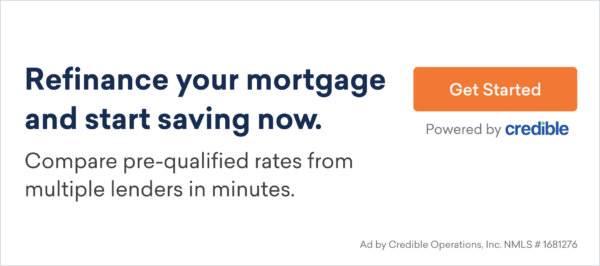Limited Cash-Out vs. No Cash-Out Refinance: How to Choose

Credible Operations, Inc. NMLS# 1681276, “Credible.” Not available in all states. www.nmlsconsumeraccess.org.
This article first appeared on the Credible blog.
Refinancing allows homeowners to replace their existing mortgage with a new home loan offering better terms. If you’re not looking to take out any equity, you’ll want to apply for a limited cash-out refinance or a no cash-out refinance.
Despite their different names, a limited cash-out refinance and a no cash-out refinance are actually the same thing: a rate-and-term refinance.
What is a limited cash-out refinance?
A limited cash-out refinance replaces your existing mortgage loan with a new loan having a lower interest rate, shorter term, or both. For example, you might replace your 30-year, fixed-rate mortgage that has a 4% interest rate with a 30-year, fixed-rate mortgage at 3% or with a 15-year, fixed-rate mortgage at 2.5%.
Good to know: A limited cash-out refinance allows you to incorporate the closing costs (including points and prepaid items) into the new mortgage. It also allows you to get a small amount of cash back. The key difference between a limited cash-out refinance and a no cash-out refinance is that a limited cash-out refinance has guidelines set by Fannie Mae. Per Fannie Mae’s rules, the cash-back amount is limited to 2% of the new loan balance or $2,000, whichever is less.
By contrast, a regular cash-out refinance can put tens of thousands of dollars in your bank account, depending on how much equity you have. Your new loan will be much larger than your old loan as a result.
With a limited cash-out refinance, your new loan may only be a few thousand dollars larger than your old loan to account for financed closing costs and the modest cash-back amount.
Find out if refinancing your mortgage is right for you.
What is a no cash-out refinance?
A no cash-out refinance also allows borrowers to replace their existing mortgage with a new one that has a different interest rate and/or different term. Like a limited cash-out refinance, you can roll your closing costs (including points and prepaid items) into your new loan and, despite what the name implies, get a small amount of cash back — albeit with use restrictions.
No cash-out refinance guidelines are set by Freddie Mac. Per Freddie Mac’s rules, the cash-back amount on a no cash-out refinance can be up to the greater of 1% of the new mortgage or $2,000. So, just as with a limited cash-out refinance, your new loan may be a few thousand dollars larger than your old loan.
Tip: An alternative to rolling closing costs into your loan is a no-closing-cost refinance. In this case, the lender typically pays your closing costs and gives you a higher interest rate. Either way, not paying closing costs up front increases your borrowing costs.
It’s smart to get at least three loan estimates for your mortgage refinance to see which lender can offer you the best interest rate and lowest fees.
Credible helps streamline this process by allowing you to compare prequalified rates from all of our partner lenders in just a few minutes.
When does a limited cash-out refinance make sense?
You might choose a limited cash-out refinance in these circumstances:
You don’t want to pay closing costs out of pocket. With a limited cash-out refi, you can roll the closing costs into your loan. This will increase your debt, but you’ll also get the benefits of refinancing without pulling money from your savings.
You don’t want to give up equity when you refinance, but you could use a bit of cash. If you want to refinance to improve your interest rate and/or loan term, and if getting a bit of cash in the process would help you, ask your lender how you can get up to $2,000 back on your loan with a limited cash-out refinance. Just make sure you’re comfortable with the long-term cost of borrowing that extra money.
When does a no cash-out refinance make sense?
Freddie Mac’s guidelines for a no cash-out refinance are slightly more generous to many borrowers. If you’re borrowing more than $200,000 or less than $80,000, Freddie Mac allows you to get more cash back on a rate-and-term refinance than Fannie Mae.
Tip: That said, taking advantage of the small cash-back amount offered by a rate-and-term refinance to save on interest in the long run might not be the best deal.
Instead, you may want to take care of closing costs upfront rather than rolling them into your new loan. Paying closing costs for your refinance up front can be a smart choice when you plan to keep your mortgage for several years. By financing as little as possible, you’ll pay less mortgage interest in the long run.
Choosing between a limited cash-out and no cash-out refinance
Borrowers don’t always know that getting a small amount of cash back is possible on a rate-and-term refinance, and lenders don’t always ask. The result? Borrowers don’t get this extra benefit that might help them if money is tight. Now you know.
If you’re refinancing and you want to get a small amount of cash back from your new loan, make sure to tell your lender.
Here are the major differences between Fannie Mae’s limited cash-out refinance and Freddie Mac’s no cash-out refinance:

If you’re considering a cash-out refinance, be sure to look at as many lenders as possible.
Credible makes finding the best deal easy — you can compare our partner lenders and see prequalified rates in as little as three minutes.
About the author: Amy Fontinelle is a mortgage and credit card authority and a contributor to Credible. Her work has appeared in Forbes Advisor, The Motley Fool, Investopedia, International Business Times, MassMutual, and more.
The post Limited Cash-Out vs. No Cash-Out Refinance: How to Choose appeared first on Credible.

 money
money 


